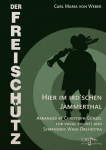Komponist:
Rota, Nino Arrangeur:
Somadossi, Marco Besetzung:
Blasorchester & Posaune
Genre:
Konzertstück • Originalwerk • Solostücke Produktart:
Partitur • Stimmensatz At the turn of the nineteenth century, after many decades in which the operatic genre dominated Italian music, the country witnessed a "renaissance" of instrumental music. A generation of composers born around 1880 (Franco Alfano, Ottorino Respighi, Ildebrando Pizzetti, Gian Francesco Malipiero, and Alfredo Casella) reaffirmed Italian musical culture in the European context. With their distinct and peculiar intentions and achievements, these composers established an “Italian school” or, at least, an Italian way of understanding modern music. This movement, with various different ramifications and influences, continued to affect and characterize Italian music production to this day. We must consider Milanese composer (Apulian by adoption) Nino Rota within the boundaries of this artistic context. Born in Milan in 1911, Rota studied music at first with his mother, a pianist. Thereafter, he became a student of James Goldsmith at the Milan Conservatory, and he continued his studies with Giulio Bas and Ildebrando Pizzetti, later graduating with his degree in composition from the Conservatory of Santa Cecilia in Rome with Alfredo Casella in 1930. An extremely prolific composer—his catalog counts at least 348 opus numbers—Rota gained considerable popularity thanks to film music by becoming the musical alter ego of director Federico Fellini: between 1952 and 1978 he composed the music for all movies directed by Fellini. He also composed the music for some of the masterpiecesin this field, such as the music for the saga of The Godfather by Francis Ford Coppola (1972-1990), Romeo and Juliet by Franco Zeffirelli (1968), and The Leopard by Luchino Visconti (1963). The fame and the success of this music, however, obscured most of the Rota’s works in the field of “art music": symphonies, concertos, chamber music, operas, and sacred music. In these compositions, although often treated with contempt by critics, we can find the real and highly original features of Rota’s music: a "stubborn mixture of skill and simplicity" that developed into a unique and highly original poetic, which does not find a counterpart in the prolific and varied panorama of Italian classical music. "I am not afraid to be melodic and catchy or—as they write—a curiously outdated character in the panorama of contemporary music. One does not find originality in a new syntax or in a new musical grammar [....]. The actuality of music is in the essence of the message that it contains, not in the outward form." The Concerto for Trombone and Orchestra, composed in 1966 is a typical example of his classical production. It was premiered at the Great Hall of the Conservatory of Milan on 6 May 1969 by the dedicatee soloist Bruno Ferrari and the Orchestra Pomeriggi Musicali of Milan directed by Franco Caracciolo. Using reduced orchestral means (strings, six woodwinds and two horns), a clear compositional writing with well-defined rhythms, and all the resources of the solo instrument, Rota composed one of the most beautiful concertos for trombone. The transcription for Symphonic Band edited by Marco Somadossi approaches original colors and musical characteristics by rendering possible an interpretation that is very close to the original for orchestra.
Folgende Optionen können gewählt werden um diese Ausgabe zu konfigurieren:



